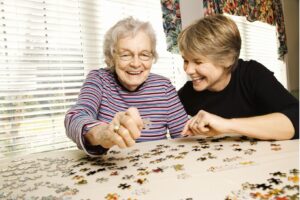A solo voice cuts through the darkened theater, a powerful soprano that is soon joined by two more in perfect harmony. At the end of a line, their voices are picked up by others, at different registers, and then more: like a burst dam the voices come rushing forth, intermingling, a sea of individuals working as one to create something beautiful. Something powerful and meaningful is born, something that lasts far beyond when the last note falls silent and is replaced by applause.
This was the scene at the Herbst Theater in San Francisco this past January, when the Community Music Center put on a concert featuring the Summit of Older Adult Choirs, sponsored in part by the Institute on Aging. In all, choirs from 7 different community centers featuring older adults joined together for a magical night of singing and togetherness. Nearly 200 singers performed in front of a packed house of more than 900, demonstrating the unity and purpose that comes when joining together. It was a powerful performance, and an equally powerful demonstration of the vital role group activities play for our aging loved ones.
Group Activities for Older Adults and the Song of Life
“For me, a ‘first timer on stage’ it was a lot of fun. I felt “mimada” (spoiled) by all who helped us.”
– Centro Latino choir member
Throughout life, we acquire talents, hobbies, and passions. No one is defined by one thing—Jack may be a dentist, but he’s also an amateur botanist, enjoys ham radio, and likes reading about the Boer War. Everyone is like that. Everyone has sides that they explore in life, things they have always been curious about.
Life often gets in the way of these explorations, especially as people age, and fall victim to a routine of medicine and checkups, and to the cultural myth that there isn’t much for older adults to do. That isn’t the case—retired and aging adults have just as much opportunity for engagement as anyone—if not more. Group activities, such as the Older Adults Choirs around the Bay Area, are open to anyone who wants to fulfill a dream, pursue a talent, or just socialize with people.
That’s the key: joining others isn’t a way to subsume individuality, but to explore it. Take Jack, our dentist friend above. He’s always been a ham radio buff, which he thought of as a solitary activity, or at least one where the connection was made over untold miles. But after he retired, and got more into the hobby, his research showed him that there were ham radio clubs all over the Bay Area. They would have meetings where’d they discuss new technology, swap tall tales, and enjoy each other’s company. For Jack, who had been spending more and more time alone, this was a great way to meet new people. Through that, he also met some new friends who were amateur historians and formed what they called the “Antique Antiquarian Society,” where they’d meet and talk about what they’ve read and wrote. It opened up a whole new avenue for Jack.
The importance of these kinds of activities, whether they are clubs, performance groups, sports teams, enthusiast societies (from gardening to gun collecting), can’t be overstated. Older adult group activities can help our aging loved ones:
- Avoid isolation. Isolation can become a spiral of loneliness, self-doubt, and sorrow. Nearly 11% of adults over 65 live alone, which can increase the risk of accident, illness, and mortality. Even those living alone have less risk of these if they see other people regularly, and have something to keep them energized.
- Lower the risk of depression. Isolation is a key cause of depression, but so is the lack of a driving purpose. For many older adults, the feeling that life has passed them by is inescapable. If they don’t have something to do, something to look forward to, depression can set in. Joining a club, coming together with other people, fights off isolation and its concomitant depression.
- Get outside of their comfort zone. Challenges are what keep us going, and for many older adults, there is an idea that trying new things is something for the past. The performer quoted above is a woman who loved singing, but had never before been on stage. It would be understandable if she was apprehensive about the new experience, but she overcame that, and in doing so, learned something new and wonderful about herself. That self-discovery never has to stop.
Group Activities as an Expression of Self
Not everyone can (or wants to) sing, or dance, or join an expressionist theater troupe, but by engaging in group activities, older adults can engage themselves in positive ways. There is therapy in music, but there is also therapy in simply joining together, doing something you love, and in doing so, fully expressing who you are.
Sadness and depression can come from not having that sense of self, from bundling everything into a false new identity—that of “being old.” We have been taught culturally to believe that an aging you isn’t really you, but someone different. That’s not the case. Joining a group activity, letting your voice mingle with others, reminds older adults that there is still a great and powerful and unique and beautiful “I,” and there always will be.
Whether looking for a group to join, professional help, or anything else related to aging at home, we’re your Bay Area partner. At the Institute on Aging, we work to educate families, caretakers, and older adults on the psychological aspects of aging. Connect with us today to learn more.







